Statues in the city centre
Statues often depict an important person or event in history. The story behind the statues in the old center takes us back in time and gives us the opportunity to learn from the past.
Kokadorus - Amstelveld

Made in 1977 by Erica van Eeghen. Kokadorus (real name: Meyer Linnewiel), born in Leeuwarden, moved to Amsterdam at a young age. He sold matches on the Kalverstraat, but when he noticed that he did well in selling, he became a stand worker. He sold toiletries and suspenders on the Amstelveld ("So strong, you can hang your mother-in-law on it!") and was known for his political comments. The story goes that he was invited by King Willem III to speak at Paleis Het Loo (palace). When he arrived there, he fell silent because of so much luxury and was not able to speak like he used to did and where they invited him for. Since 1906 he called himself Professor Kokadorus. Where that name came from is not certain, it may be a combination of the names of his grandfather Ko, his grandmother Ka and his father Dorus, but in reality these persons appear to have been called differently. In 1934 Kokadorus "De Keizer der Standwerkers" (The Emperor of the Standworkers) or as he called himself “De Koopman van Noord-Venetië" (The Merchant of Northern Venice). The statue shows Kokadorus praising his braces.
Thorbecke - Thorbeckeplein
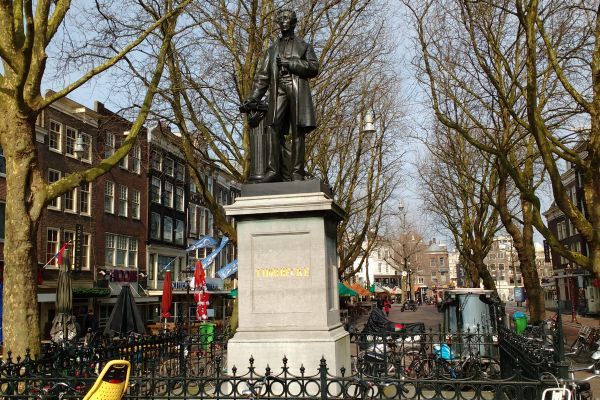
Made in 1876 by Ferdinand Leenhoff. Johan Rudolph Thorbecke is the founder of democracy in the Netherlands. In 1848, King Willem II ordered Thorbecke to rewrite the constitution. By direct elections, the people gained more power, which led to the modern state and democracy as we know it today. Thorbecke was Minister of Foreign Affairs three times. The statue was unveiled four years after Thorbecke's death, on May 18 in 1876. Thorbecke is holding a briefcase under his arm and the Constitution in his hand. The statue is located on the Thorbeckeplein, facing the Reguliersgracht. After the work on the square in 2011, the statue would be rotated; however, this never happened for inexplicable reason.
Henk Henriët - Marnixplein

Made in the 1930s by Henk Henriët. Tonia Sluyter, wife of the artist, modeled this statue called 'De Volksvrouw' (The Folk women). It represents all the women who managed to get through the crisis of these years. The woman looks with a strong look at the Lijnbaansgracht and radiates strength with her arms folded. Henk Henriët and Tonia Sluyter did not have much at the time. However, Henk always stood for his opinion: he was a member of the communist side. It was not until 1967 that the plaster model was cast in bronze and placed on Marnixplein.
Anne Frank - Westermarkt
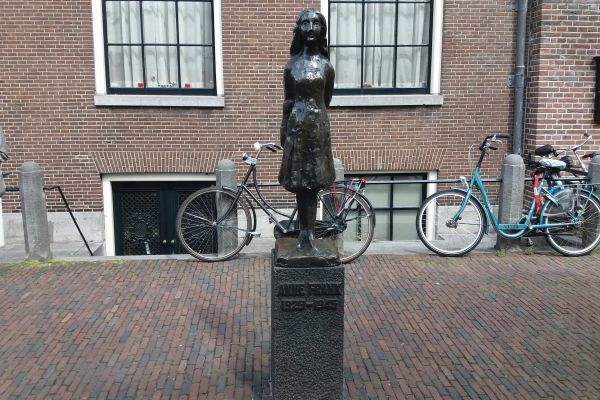
Made in 1977 by Mari Andriessen. Just a few meters from the Frank family's hiding place, on the corner of the Prinsengracht and the Westermarkt, this bronze statue commemorates the 15-year-old Anne Frank who was murdered in the Bergen-Belsen concentration camp during the Second World War. The statue was unveiled on March 14 in 1977 by Mayor Samkalden. People suspect that March 14 was the day that Anne Frank died. The statue shows Anne with her hands on her back as she looks up with hope as we know her from the diaries.
Theo Thijssen - Lindengracht
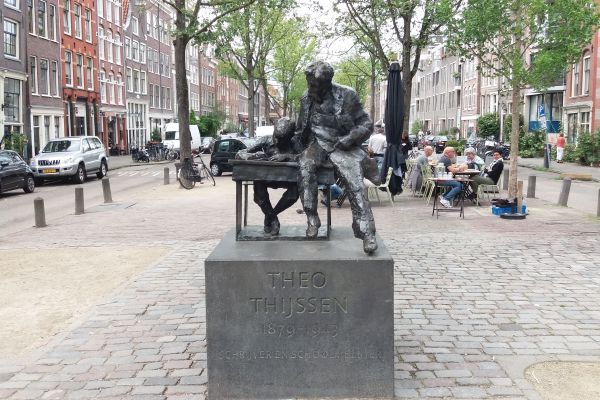
Made in 1979 by Hans Bayens. On the 100th birthday of writer Theo Thijssen, his statue was unveiled by the that time mayor Wim Polak. Theo Thijssen is known for the novel "Kees de Jongen" about the almost 12 year old Kees Bakels. And many people know Kees Bakels from 'De zwembadpas' (the swimming pool walk). It was a special way of walking that made you progress faster, thought up by Kees. You walk as if you were falling forward. Theo Thijssen was much more besides being a writer. He was a teacher, unionist, social democratic Member of Parliament and above all Amsterdam and a real Jordaan resident. Born here as the son of a cleaner, he went to the Rijkskweekschool voor Onderwijzers in Haarlem with a grant from the state. Despite the very authoritarian education at the time, Thijssen always placed the children in the center and assumed that going to school and having lessons for children should be fun.
Woutertje Pieterse en Femke - Noordermarkt
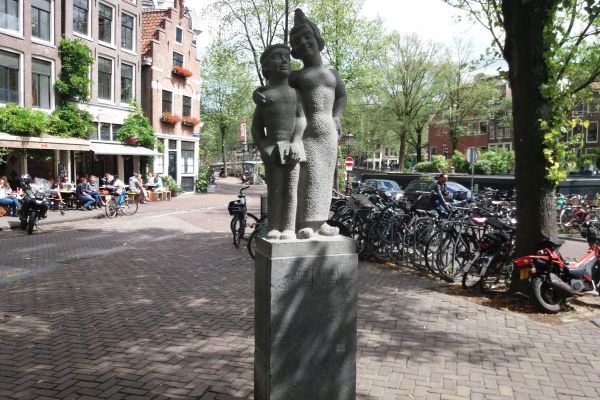
Made in 1976 by Frits Sieger. The statue was placed in honor of the book 'Woutertje Pieterse' written by Multatuli. It was Multatuli's second novel and one of his best known after 'Max Havelaar'. Multatuli initially did not want to publish the book; his widow did it after his death, so he never enjoyed the success. Woutertje Pieterse is an Amsterdam boy with many dreams and curiosity, but he is inhibited by the petty-bourgeois nature of his environment. A boy with many ideas who is annoyed by the narrow-mindedness and lack of openness to change. In the book, he protects Femke from a bunch of bad boys and gets a kiss as a reward. This took place on the Noordermarkt, which is why the statue of the two characters is located here. The book is considered as one of the classics in Dutch literature.
Multatuli - Torensluis
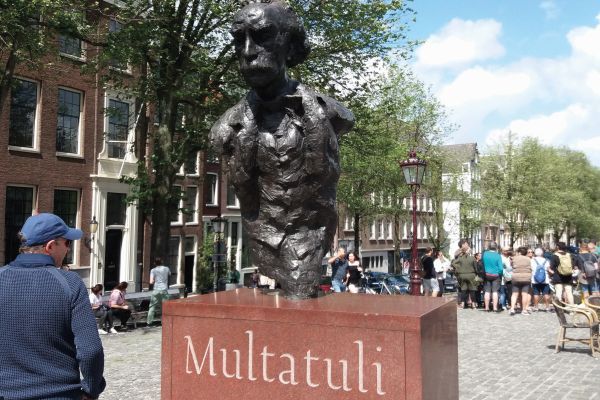
Made in 1987 by Hans Bayens. The statue was unveiled by Queen Beatrix and was made on the occasion of the 100th anniversary of the death of Eduard Douwes Dekker, who wrote under the pseudonym Multatuli. His most famous work is 'Max Havelaar': an indictment against the exploitation and oppression of the people of the Dutch East Indies. A few blocks away is the address that Dekker mentioned in Max Havelaar, where the fictional coffee brokerage "Last & Co" is said to be located at 37 Lauriergracht. At that time a monastery was located at this address and therefore no coffee brokerage. There are now residential houses, with a sign next to the door with the name of the coffee merchant.
Johnny Jordaanplein
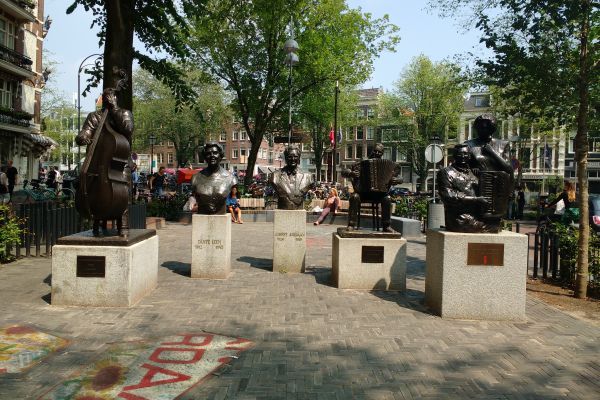
This square is entirely dedicated to Amsterdam's most famous folk singers. After the death of Johnny Jordaan in 1989, money was collected for a statue, which eventually was placed. In 1991 an action was set up to also name this part of the Jordan after the folk singer. Not much later, the Johnny Jordaanplein was a fact. Later, statues were added of Tante Leen (1994), Johnny Meijer (1996), Manke Nelis (2005) and Bolle Jan and Mien Froger (2010).
Eenheid de Sterkste Keten - Noordermarkt
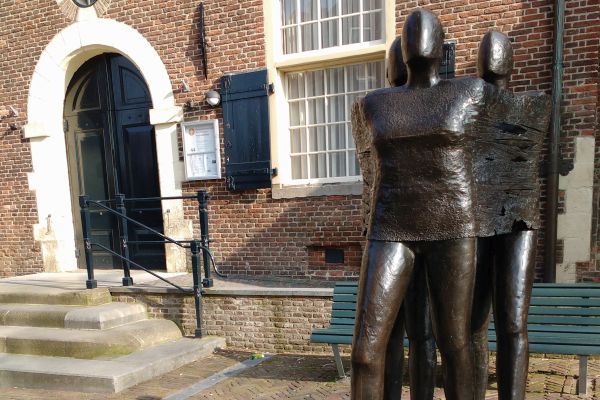
Made in 1987 by Sophie Hupkens. This statue is placed in memory of the Jordaan rebellion in 1934. They are three women who are connected by a wide band. This symbolizes the women who united against the discount measures taken by Colijn, which caused the Jordaan rebellion. Unemployment was high during the 1930s crisis, particularly in working-class neighborhoods such as the Jordaan. Families lived in small houses with poor living conditions and were starving. On the 4th of July 1934, a protest meeting took place in the Jordaan, organized by the 'Werlozen Strijd Comité'. After this meeting, visitors came out on the streets, which led to a violent demonstration. The uprisings were not over the next day; residents threatened to burn bridges, streets were barricaded and not able to enter. The police and later even the army acted hard on behalf of Prime Minister Hendrik Colijn. Many were injured and even killed. On the 9th of July, the rebellion was almost over and the damage was repaired. Despite the fact that there were uprisings in other neighborhoods, nowhere was it as violent as in the Jordaan.


